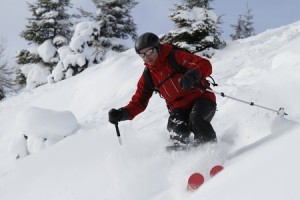Rock out your powder skis

If your powder skis are more than 15 years old, now is the time to look into rocker skis or a rockered snowboard. This technology sheds a whole new light on powder skis.
What is a rocker ski? It’s a relatively new profile for a ski or board that resembles the feet of a rocking chair. This shape provides several advantages for powder skis. The term derives from water skiing, where the rocker profile originated. Traditionally, downhill skis have camber, an upward bend in the midsection. Unweighted, a cambered ski touches the snow at the tip and tail. This enhances edge grip, improving the response, power and precision when carving turns on packed or groomed snow, and they are more stable and precise on icy snow. Camber also provides spring or pop when coming out of turns.
On the other hand, cambered designs might not be the best for someone looking for powder skis. Camber pushes the edges into the snow, require more power to turn in powder.
Rockered skis are the opposite, with an upward curve at the tip and tail. They’re also known as reverse camber, inverse camber, negative camber or early rise. This shape allows a ski to float over powder. Because less of its surface is in contact with the snow, initiating turns is easier and there’s less chance of catching an edge. Some park riders also prefer rockered skis for tricks and rails.
Although they’re more forgiving as powder skis, rocker design tends to reduce performance on hard-packed or icy trails. With less contact surface, there’s less edge grip on icy or hard-packed snow, as well.
Varieties
Rocker skis were first introduced to the market in 2002 with the Volant Spatula, but since then, almost every ski and board manufacturer has brought out rocker skis, with any number of variations in the design. Some models have more rocker, or upward curve, with others have only a slight early rise in the tip. Some have rocker in the tip and the tail, while others place it along the full length of the ski. Some manufacturers have modified the amount of sidecut in their rocker skis, as well.
A greater amount of tip rocker improves float on powder. Early rise also enables these powder skis to climb over soft snow.
Tail rocker, at the back of the ski, enables you to ski backward in powder. The rise in the tail also help with riding forward in powder, because the ski does not sink as deeply into the snow. Again, rocker at either end reduces precision on hard-packed snow.
There are even models that combine rocker and camber to try to achieve the advantages of both—namely, the ability to float over powder and gain precision on packed snow.
